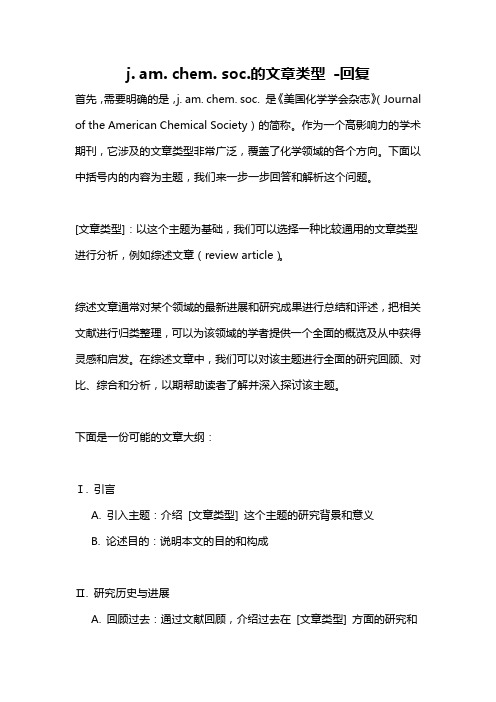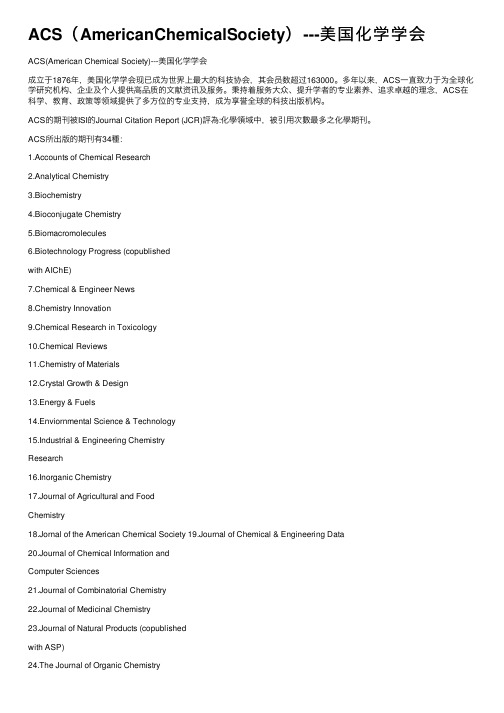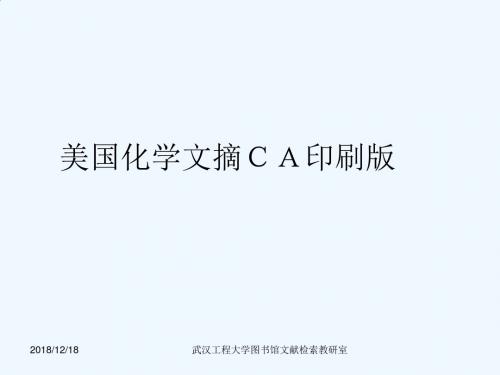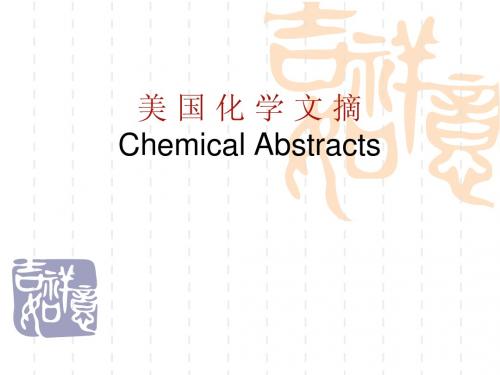C-F形成的综述—美国化学协会Chemical review
化学类SCI期刊分区表及影响因子

CATAL REV
CATALYSIS REVIEWS-SCIENCE AND ENGINEERING
INT REV PHYS CHEM
INTERNATIONAL REVIEWS IN PHYSICAL CHEMISTRY
J PHOTOCH PHOTOBIO C
JOURNAL OF PHOTOCHEMISTRY AND PHOTOBIOLOGY CPHOTOCHEMISTRY REVIEWS
J MASS SPECTROM
JOURNAL OF MASS SPECTROMETRY
J PHYS CHEM REF DATA JOURNAL OF PHYSICAL AND CHEMICAL REFERENCE DATA
J PHYS CHEM REF DATA JOURNAL OF PHYSICAL AND CHEMICAL REFERENCE DATA
J CHEM INF MODEL
Journal of Chemical Information and Modeling
J CHEM INF MODEL
Journal of Chemical Information and Modeling
J CHEM INF MODEL
Journal of Chemical Information and Modeling
BIOMACROMOLECULES
BIOMACROMOLECULES
BIOMACROMOLECULES
BIOMACROMOLECULES
J ORG CHEM
JOURNAL OF ORGANIC CHEMISTRY 有机化学杂志 美国
ORGANOMETALLICS
ORGANOMETALLICS
j. am. chem. soc.的文章类型 -回复

j. am. chem. soc.的文章类型-回复首先,需要明确的是,j. am. chem. soc. 是《美国化学学会杂志》(Journal of the American Chemical Society)的简称。
作为一个高影响力的学术期刊,它涉及的文章类型非常广泛,覆盖了化学领域的各个方向。
下面以中括号内的内容为主题,我们来一步一步回答和解析这个问题。
[文章类型]:以这个主题为基础,我们可以选择一种比较通用的文章类型进行分析,例如综述文章(review article)。
综述文章通常对某个领域的最新进展和研究成果进行总结和评述,把相关文献进行归类整理,可以为该领域的学者提供一个全面的概览及从中获得灵感和启发。
在综述文章中,我们可以对该主题进行全面的研究回顾、对比、综合和分析,以期帮助读者了解并深入探讨该主题。
下面是一份可能的文章大纲:Ⅰ. 引言A. 引入主题:介绍[文章类型] 这个主题的研究背景和意义B. 论述目的:说明本文的目的和构成Ⅱ. 研究历史与进展A. 回顾过去:通过文献回顾,介绍过去在[文章类型] 方面的研究和发展情况B. 当前挑战:讨论目前研究领域的挑战和问题Ⅲ. [文章类型]方法与技术A. 介绍常用的[文章类型] 实验方法和技术B. 分析这些方法和技术的优缺点Ⅳ. [文章类型]应用与前景A. 阐述[文章类型] 在不同领域的应用案例B. 展望[文章类型] 的未来发展方向和可能的研究热点Ⅴ. 结论A. 总结本文的主要内容和观点B. 强调[文章类型] 的重要性和潜在的贡献在这份大纲的基础上,我们可以逐步展开文章内容,提取相关文献进行综述,并且可以加入自己的观点和分析。
总体而言,一篇关于[文章类型] 主题的综述文章应该具备以下特点:全面回顾、系统综合、观点独特、观点支持。
通过这样的文章,我们可以向读者传达对该主题的全面理解和深入见解,并为进一步研究和创新性思考提供思路和基础知识。
需要注意的是,以上仅仅是对一种可能的文章类型进行解析和概述,并不能代表所有的j. am. chem. soc. 文章类型。
化学文摘(Chemical Abstracts,CA)

普通副标题:
有七个,按字母顺序排列:analysis(分析)有关
化学物质的成分检测方法及属于分析目的的分析方面
文献。biological studies(生物学研究)有关生物
用途和在生物毒性等方面文献。occurrence
(存在)有关生物系统外的自然存在方面文献 preparation(制备)有关合成、制造、精制、分离、 回收等方面文献。properties(性质)有关物理、化 学性质等方面文献。reactions(反应)化学反应方 面文献。use and miscellaneous(用途及其他)。
B. 化学物质索引的编排:先按主标题词字 顺排列,主标题词相同,再按副标题词类 别字顺排列,而复标题中先排限定性副标 题词,再排功能基标题词。若副标题词相 同,按说明语字顺排列。
化学物质索引(Chemical
Substance Index)
例:Benzoic acid(1)
-------, 4-[(1,5-dimethylhexyl)oxy]-(2)
min.occurs that corresponds to miscibility between oil
and water phases……
①CA卷号:文摘号;②文献篇名;③作者姓名;④作 者单位(通讯地址);⑤文献出处项:刊载该文献的期 刊刊名(2002年以前用缩略语,可用辅助工具CASSI查刊 名全称。如,J. Dispersion Sci. Technol.),出版年,卷号 (期号),起止页码;⑥原文文种;⑦出版者;⑧文献 摘要
9) Biochemical Methods (生物化学方法)
10) Microbial, Algal, and Fungal Biochemistry (微生物 、藻类和真菌生物化学)
化学期刊文档

化学期刊介绍化学期刊是一类专门发表化学研究成果的学术期刊。
化学期刊以发表原创的研究论文、综述文章和通讯为主,旨在促进化学领域的学术交流和科研发展。
化学期刊在学术界具有重要的地位,是化学学者们交流科研成果、获取最新研究动态的重要渠道。
历史发展化学期刊的历史可以追溯到17世纪。
最早的化学期刊可以追溯到1665年,当时英国皇家学会(Royal Society)创办了《哲学简报》(Philosophical Transactions),这也是世界上最早的科学期刊之一。
化学领域的第一本专门期刊是于1789年由法国化学家Guillaume-Francois Rouelle创办的《脱路易斯的新化学研究报告》(Annales de chimie)。
随后,各国相继创办了一系列化学期刊,如德国的《化学新闻》(Chemische Nachrichten)和美国的《美国化学协会杂志》(Journal of the American Chemical Society)等。
期刊类型化学期刊根据其发表原则和内容形式,可以分为以下几类:专业期刊专业期刊是指面向特定化学领域的学术期刊,如有机化学、无机化学、物理化学等。
这类期刊特点是发表相关领域的原创研究成果,对该领域的学术交流有重要影响。
如有机化学领域的《有机化学》(Organic Chemistry)和《化学通讯》(Chemical Communications)等。
综述期刊综述期刊是指系统概述某个化学领域最新研究进展的期刊,以综述文章为主。
这些文章通常由领域内专家撰写,向读者介绍该领域的最新动态、研究前沿和重要突破等。
如《化学综述》(Chemical Reviews)和《化学观察》(Chemical Science)等。
通讯期刊通讯期刊是指发表具有重大科学意义和突破性质量的研究成果的期刊。
这类文章通常较短,篇幅较小,但对于领域内的科学家有重大影响。
如《自然通讯》(Nature Communications)和《科学快报》(Science Advances)等。
化学影响因子

Annu. Rev. Phys. Chem.(Annual Review of Physical Chemistry) 物理化学(综述性) 发行者:Annual Reviews 影响因子:11.250
Surf. Sci. Rep.(Surface Science Reports) 物理化学/凝聚态物理(综述性) 发行者:Elsevier 影响因子:9.304
Catal. Rev.-Sci. Eng.(Catalysis Reviews-Science and Engineering) 物理化学(综述性) 发行者:Talor & Francis 影响因子:9.222
Curr. Opin. Chem. Biol.(Current Opinion in Chemical Biology) 生物化学和分子生物学/生物物理(综述性) 发行者:Current Biology Ltd. 影响因子:8.320
Chem. Biol.(Chemistry & Biology) 生物化学和分子生物学 发行者:Cell 影响因子:6.677
Gold Bull.(Gold Bulletin) 无机化学/材料科学/冶金学和冶金工程 发行者:World Gold Council(世界黄金协会) 影响因子:6.029
Nat. Prod. Rep.(Natural Product Reports) 生物化学和分子生物学/医药化学/有机化学(综述性) 发行者:Royal Society of Chemistry(英国皇家化学会) 影响因子:8.889
美国化学文摘

CA收录的文献范围几乎涉及所有的自然科学, 但生命科学是其报道重点,在报道的所有文献中超 过1/3(35.5%)的文献为生物医学文献。CA所摘录 的1000种核心期刊中,有关生化、生理、微生物、 环境医学、药理、临床医学等学科的期刊占1/3,包 含了最重要的医学核心期刊。
3.CA收录了世界上大多数医学、生物学期刊 CA收录的8000多种期刊中,有5000多种与生物医学有关(其中只有37% 的期刊被IM收录) ;
(一)按照化学物质的不同,分为5部 分共80大类。
5部分别为
Biochemistry section(生物化学部分) 1-20 Organic Chemistry Sections(有机化学部分)21-34
Macromolecular Chemistry Section(大分子化学部分) 35-46 Applied Chemistry and Chemical Engineering Section(应 用化学和化学工程) 47-60 Physical,Inorganic and Analytical Chemistry Sections(物 理,无机化学和分析化学) 61-80
⑵534e ⑶Novel
3 860h Liver-directed gene transfer vectors.
987e The UGT1A1*28 allele is relatively rare in a Japanenes population.
⑴大类号 ⑵文摘号,黑体字
⑶文献篇名
二、索引与检索方法
of the Hydrodynamic Contribution to Peak Asymmetry in High-performance Liquid Chromatography Using the Equilibrium-Dispersive Model. ⑶Stanley, Brett J.; Savage, Theresal.; Geraghty, Jennifer J.⑷(Department of Chemistry, California State University, San Bemardino, CA, 92407-2397, USA). ⑸Anal. Chem.⑹1998, 70(8), 1610-1617 ⑺ (Eng), ⑻American Chemical Society. ⑼The present investigation…..
化学化工专业英语(1)

例如:
The operation of a machine needs some knowledge of its performance. 操作机器需要懂得机器的一些性能。 (n.→v.) The continuous process can ordinarily be handled in the less space. 连续过程通常能节省操作空间。 (adj.→v.)
Syllabus?(课程纲领)
本书共分为三部分: 第一部分为“科技英语翻译方法”; 第二部分为“专业文章阅读与翻译”; 第三部分为“科技论Exam (1): close-book exam, covering all nomenclature, dictionary NOT allowed Exam (2): open-book, comprehensive, dictionary allowed
科技著作、科技论文及报告、实验报告及方 案; 各类科技情报及文字资料; 科技实用手册的结构描述和操作规程; 有关科技问题的会谈、会议; 有关科技的影片、录像及光盘等有声资料的 解说词等。
科技英语要求其客观性、准确性及 严密性,注意叙事逻辑上的连贯及表 达上的明晰、畅达,避免行文晦涩。 科技英语力求平易和精确,避免使用 旨在加强语言感染力和宣传效果的各 种修饰词,以免使读者产生行文浮华, 内容虚饰之感。
2.被动语态多
1.据语言学家统计,物理、化学、工程类的教科书里, 约有1/3的动词用于被动语态句。 2. 这是因为科技人员最最关心的是行为、活动、事实 本身,至于谁做的,无关紧要,而且运用被动语态显 得文章所描述的内容更客观,可减少一些主观印象。 例如: Mathematics is used in many different fields. people use mathematics in many different fields.
ACS(AmericanChemicalSociety)---美国化学学会

ACS(AmericanChemicalSociety)---美国化学学会ACS(American Chemical Society)---美国化学学会成⽴于1876年,美国化学学会现已成为世界上最⼤的科技协会,其会员数超过163000。
多年以来,ACS⼀直致⼒于为全球化学研究机构、企业及个⼈提供⾼品质的⽂献资讯及服务。
秉持着服务⼤众、提升学者的专业素养、追求卓越的理念,ACS在科学、教育、政策等领域提供了多⽅位的专业⽀持,成为享誉全球的科技出版机构。
ACS的期刊被ISI的Journal Citation Report (JCR)評為:化學領域中,被引⽤次數最多之化學期刊。
ACS所出版的期刊有34種:1.Accounts of Chemical Research2.Analytical Chemistry3.Biochemistry4.Bioconjugate Chemistry5.Biomacromolecules6.Biotechnology Progress (copublishedwith AIChE)7.Chemical & Engineer News8.Chemistry Innovation9.Chemical Research in Toxicology10.Chemical Reviews11.Chemistry of Materials12.Crystal Growth & Design13.Energy & Fuels14.Enviornmental Science & Technology15.Industrial & Engineering ChemistryResearch16.Inorganic Chemistry17.Journal of Agricultural and FoodChemistry18.Jornal of the American Chemical Society 19.Journal of Chemical & Engineering Data20.Journal of Chemical Information andComputer Sciences21.Journal of Combinatorial Chemistry22.Journal of Medicinal Chemistry23.Journal of Natural Products (copublishedwith ASP)24.The Journal of Organic Chemistry25.The Journal of Physical Chemistry A&B/doc/e7c8a90b79563c1ec5da7171.html ngmuir27.Macromolecules28.Modern Drug Discovery29.Nano Letters (coming in 2001)/doc/e7c8a90b79563c1ec5da7171.html anic Letters/doc/e7c8a90b79563c1ec5da7171.html anic Process Research &Development(copublished with RSC)/doc/e7c8a90b79563c1ec5da7171.html anometallics33.T oday’s Chemist at Work34.Bulletin of the Chemical Society of Japan(Published by CSJ)在這些ACS的出版物中,内容涵蓋了24個主要的領域。
化学学科平均影响因子化学影响因子

化学学科平均影响因子化学影响因子JCR最近(2006年)统计的期刊中,化学类影响因子大于6的有:Chem. Rev.(Chemical Reviews) 化学(综述性) 发行者:American Chemical Society(美国化学会) 影响因子:26.054Acc. Chem. Res.(Accounts of Chemical Research) 化学(综述性) 发行者:American Chemical Society(美国化学会) 影响因子:17.113Chem. Soc. Rev.(Chemical Society Reviews) 化学(综述性) 发行者:Royal Society of Chemistry(英国皇家化学会) 影响因子:13.690Angew. Chem.-Int. Ed.(Angewandte Chemie-International Edition) 化学发行者:Wiley 影响因子:10.232Nano Lett.(Nano Letters) 化学/纳米科技/材料科学发行者:American Chemical Society(美国化学会) 影响因子:9.960Adv. Mater.(Advanced Materials) 化学/物理化学/材料科学发行者:Wiley 影响因子:7.896J. Am. Chem. Soc.(Journal of American Chemical Society) 化学发行者:American Chemical Society(美国化学会) 影响因子:7.696Small 化学/纳米科技/材料科学/应用物理/凝聚态物理发行者:Wiley 影响因子:6.024Coord. Chem. Rev.(Coordination Chemistry Reviews) 无机化学(综述性) 发行者:Elsevier 影响因子:8.815Adv. Organomet. Chem.(Advances in Organometallic Chemistry) 无机化学/有机化学(综述性) 发行者:Elsevier 影响因子:6.850Gold Bull.(Gold Bulletin) 无机化学/材料科学/冶金学和冶金工程发行者:World Gold Council(世界黄金协会) 影响因子:6.029Nat. Prod. Rep.(Natural Product Reports) 生物化学和分子生物学/医药化学/有机化学(综述性) 发行者:Royal Society of Chemistry(英国皇家化学会) 影响因子:8.889Med. Res. Rev.(Medicinal Reseach Reviews) 医药化学/药理学和药剂学(综述性) 发行者:Wiley 影响因子:7.218Aldrichimica Acta 有机化学发行者:Aldrich Chemical Co. Inc. 影响因子:10.692Nat. Mater.(Nature Materials) 物理化学/材料科学/应用物理/凝聚态物理发行者:Nature 影响因子:19.194Adv. Catal/(Advances in Catalysis) 物理化学(综述性) 发行者:Elsevier 影响因子:11.250Annu. Rev. Phys. Chem.(Annual Review of Physical Chemistry) 物理化学(综述性) 发行者:Annual Reviews 影响因子:11.250Surf. Sci. Rep.(Surface Science Reports) 物理化学/凝聚态物理(综述性) 发行者:Elsevier 影响因子:9.304Catal. Rev.-Sci. Eng.(Catalysis Reviews-Science and Engineering) 物理化学(综述性) 发行者:T alor & Francis 影响因子:9.222J. Photochem. Photobiol. C(Journal of Photochemistry and Photobiology C) 物理化学(综述性) 发行者:Elsevier 影响因子:7.320Adv. Funct. Mater.(Advanced Functional Materials) 物理化学/材料科学/应用物理/凝聚态物理发行者:Wiley 影响因子:6.779Prog. Nucl. Magn. Reson. Spectrosc.(Progress in Nuclear Magnetic Resonance Spectroscopy) 物理化学/化学物理学(综述性) 发行者:Elsevier 影响因子:6.417Int. Rev. Phys. Chem.(International Reviews in Physical Chemistry) 物理化学(综述性) 发行者:T alor & Francis 影响因子: 6.036Annu. Rev. Biochem.(Annual Review of Biochemistry) 生物化学和分子生物学(综述性) 发行者:Annual Reviews 影响因子:36.525Annu. Rev. Biophys. Biomolec. Struct.(Annual Review of Biophysics and Biomolecular Structure) 生物化学和分子生物学/生物物理(综述性) 发行者:Annual Reviews 影响因子:16.921T rends Biochem.Sci.(Trends in Biochemical Sciences) 生物化学和分子生物学(综述性) 发行者:Elsevier 影响因子:13.863Nat. Chem. Biol.(Nature Chemical Biology) 生物化学和分子生物学发行者:Nature 影响因子:12.409Curr. Opin. Chem. Biol.(Current Opinion inChemical Biology) 生物化学和分子生物学/生物物理(综述性) 发行者:Current Biology Ltd. 影响因子:8.320Chem. Biol.(Chemistry & Biology) 生物化学和分子生物学发行者:Cell 影响因子:6.677Prog. Polym. Sci.(Progess in Polymer Science) 高分子科学(综述性) 发行者:Elsevier 影响因子:14.818百度搜索“就爱阅读”,专业资料,生活学习,尽在就爱阅读网,您的在线图书馆。
含氟药物研究进展和芳_杂_环氟化_省略__n_1_2_3_氟甲基化新方法_张霁

(HEC Pharm Group, HEC Research and Development Center, Dongguan 523871) Abstract This review outlines the recent advances of fluorinated drugs and latest research overview from the perspective of a medicinal chemist wherein the synthesis and use of trifluoromethylation, difluoromethylation, monofluoromethylation and fluorinated aromatic (heterocyclic) compounds are highlighted. It is pointed out that the full use of the latest progress in fluorine chemistry provides a shortcut to new fluorinated compounds or previously difficult to prepare compounds which is worth exploring for drug discovery. Keywords fluorine; fluorinated drugs; fluorination; trifluoromethylation; difluoromethylation; monofluoromethylation; drug design
* E-mail: zhangji@ Received October 29, 2013; revised December 9, 2013; published online December 19, 2013. Project supported by the Introduction of Innovative R&D Team Program of Guangdong Province. 广东省引进创新科研团队计划资助项目.
有机化学文献简介

有机化学文献简介有机化学文献简介(1)文献按内容区分有一次文献, 二次文献和三次文献. 一次文献即原始文献, 例如期刊, 杂志, 专利等作者直接报导的科研论文. 二次文献指检索一次文献的工具书, 例如美国化学文摘及其相关索引. 三次文献为将原始论文数据归纳整理形成的综合资料, 例如综述, 图书, 词典, 百科全书, 手册等.下面简述几种常用的有机化学文献:(一). 三次文献(1). 词典类:i). 英汉,汉英化学化工大词典: 编辑简洁明了, 是查阅化学名词英翻中或中翻英方便省时的工具书. 阅读英文化学书籍或期刊论文, 有些英文单字在一般英文字典查不到, 需要用英汉化学词典, 例如 menthol (薄荷醇); 汉英化学词典在写作英文化学论文时特别需要, 也是出国必备, 例如共轭二烯的英文为 conjugated diene. 较著名的有以下几种版本:a. 英汉,汉英化学化工大词典(学苑出版社): 英汉和汉英分别报导 12万和14万条目.b. 英汉,汉英化学化工词汇(化学工业出版社): 分为英汉和汉英两个单行本, 各报导8万个条目, 携带方便.c. 英汉化学化工词汇(科技出版社): 列出 17 万条目, 报导详尽.ii). 化合物命名词典 (上海竹书出版社): 介绍化合物的命名规则, 有 7000 多个例子, 依序报导无机化合物(一元, 二元, 多元化合物, 无机酸和盐, 配位化合物), 有机化合物(脂肪族, 碳环, 杂环, 天然产物以及含各种官能基化合物) 的命名介绍. 每个化合物给结构式及同义词的中英文名字. 例如 C6H5OCH3 anisole (茴香醚), methoxybenzene (甲氧基苯), methyl benzyl ether (苯甲醚). 本词典索引齐全, 有分子式索引, 名字索引. 名字索引按照中文笔画排序, 或按照中文或英文拼音排序.(2). 安全手册: 初入实验室的学生以及首次使用某化学品的人员应了解清楚实验所涉及的化学品的性质及其危险指标.i). 常用化学危险物品安全手册(中国医药科技出版社): 报导约 1000种使用, 生产, 运输中最常见的化学药品的安全资料. 报导内容有: 化合物的理化性质, 毒性, 包装运输方法, 防护措施, 泄漏处置, 急救方法(例如皮肤接触溴, 用水冲洗10分钟后再用 2% 碳酸氢钠溶液冲洗; 食入溴立即漱口, 饮用牛奶及蛋清). 本书按照中文笔画排序, 卷末有英文索引, 以及中英对照, 英中对照索引.ii). 化学危险品最新实用手册(中国物资出版社): 报导约 1300 种化学药品的性状(外观, 气味, 熔点, 沸点, 闪点, 密度, 折射率), 危险性(剧毒, 低毒, 致癌, 遇水释放毒气), 禁忌(怕水, 火, 高热), 贮存和运输方式, 泄漏处理, 防护急救措施等.(3). 百科全书, 大全, 手册, 目录i). The Merck Index (默克索引): 是德国 Merck 公司出版的非商业性的化学药品手册, 其自称是“化学品, 药品, 生物试剂百科全书”. 报导1万种常用化学和生物试剂的资料. 描述简洁, 字数数十至数百, 以叙述方式介绍该化合物的物理常数(熔点, 沸点, 闪点, 密度, 折射率, 分子式, 分子量, 比旋光度, 溶解度), 别名, 结构式, 用途, 毒性, 制备方法以及参考文献. 默克索引已经成为介绍有机化合物数据的经典手册, CRC, Aldrich 等手册都引用化合物在默克索引中的编号.书的后半部简单介绍有著名的有机名称反应 (Name Reactions), 例如 acyloin condensation, Knorr pyrrole synthesis, Curtiues rearrangement 等. 书中刊出许多表格, 报导实用资料, 例如缩写, 放射性同位素含量, Merck编号与 CA 登记号的对照表, 重要化学试剂生产公司等. 本书编排按照英文字母排序, 书末有分子式及名字索引.ii). Dictionary of Organic Compounds (有机化合物字典), 简称 DOC, 1934 年首版, 每几年出一修订版, 是有机化学, 生物化学, 药物化学家重要的参考书. 内容和和排版与 Merck Index 类似, 但数目多了近十倍, 报导10多万种化合物的资料. 按照英文字母排序, 有许多分册, 刊载化合物的分子式, 分子量, 别名, 理化常数(熔点, 沸点, 密度等), 危险指标, 用途, 参考文献. 因为数目庞大, 另外出版有索引分册, 包括分子式索引(例如 C5H13N, 2-Pentylamine, P-00561), CA登记号对照索引(例如 60-35-5, acetamide, A-00092), 名字索引(例如Bromoacetic acid, see B-01884).iii). Handbook of Chemistry and Physics (CRC 化学物理手册), 简称 CRC, 是美国化学橡胶公司 (Chemical Rubber Company) 出版的理化手册. 1913 年首版, 目前已出第 79 版本(1999 年). 早期(例如第63 版) 内容分为6大类, 报导数学用表, 无机, 有机, 普化, 普通物理常数, 及其它. 目前扩充报导14 部, 包括基本常数单位 (section 1), 符号和命名 (section 2), 有机 (section 3), 无机 (section 4), 热力学动力学 (section 5), 流体 (section 6), 生化(section 7), 分析 (section 8) 等. 其中第3部的有机化学报导占 740 页, 用表格很简略的介绍12000 种化合物的理化资料(例如分子量, 熔点, 沸点, 密度, 折射率, 溶解度), 以及别名, Merck index 编号, CAS 登记号, 及在Beilstein 的参考书目 (Beil. Ref) 等. Beilstein 参考书目的写法早期为 B84, 252, 新版改为 4-08-00-00252, 代表在Beilstein 第4系列(补篇)第8卷252页(新版的 00 表附卷). 化合物的名字排序仿照美国化学文摘, 以母体化合物为主, 例如p-bromoaniline (对溴苯胺) 查法为 Benzenamine, 4-bromo.紧接着表格, 刊出有以上1万多种化合物的结构式. 本章后面的索引有同义词索引, CAS 登记号索引等.CRC 是个多用途的手册, 其它章节报导有科技名词的定义, 命名规则, 数学公式, 还有许多表格刊载例如蒸汽压, 游离能, 键角键长等有用的资料.早期的 CRC 有机部分有熔点 (-197 - 913 °C) 和沸点索引 (-164 - 891 °C), 可以从熔点沸点数据查出可能的化合物结构. CRC 根据International System of Units, Symbols and Terminology for Physical and Chemical Quantities, Definitions of Scientific Term System 的规定, 列出了书百个国际承认的单位, 符号, 名称的缩写.iv). Lange’s Handbook of Chemistry (兰氏化学手册): 内容和 CRC 类似, 分11章分别报导有机, 无机, 分析, 电化学, 热力学等理化资料. 其中第七章报导有机化学, 刊载 7600 种有机化合物的的名称, 分子式, 分子量, 熔点, 沸点, 闪点, 密度, 折射率, 溶解度, 在Beilstein 的参考书目等. 其它章节报导有介电常数, 偶极炬, 核磁氢谱碳谱化学位移, 共沸物的沸点和组成等有用的资料. 本手册有中文翻译本出版.v). Beilstein Handbuch der Organischen Chemie (贝尔斯坦有机化学大全): 简称Beilstein, 为德国化学家 Beilstein 编写, 1882 年首版, 之后由德国化学会编辑, 以德文书写, 是报导有机化合物数据和资料十分权威的巨著. 内容介绍化合物的结构, 理化性质, 衍生物的性质, 鉴定分析方法, 提取纯化或制备方法以及原始参考文献. Beilstein 所报导化合物的制备有许多比原始文献还详尽, 并且更正了原作者的错误. 虽然德文不如英文普遍, 但是许多早期的化学资料仍需借助 Beilstein查询, 加上目前 Beilstein Onlin 网络的流行(价格比 CA 便宜广用), 因此学习和了解 Beilstein 的编辑和使用方法仍是不可免的.Beilstein 目前出版有 7 大系列( H, E I, E II, E III, E III/IV, E IV, E V), 其中 H 表Hauptwerk (正编), E 表 Erganzungswerk (补编). H 系列为基本系列 (Basic Series), 报导1910 年以前的文献资料, 之后每10年增加一个系列(补篇). 后面的补编逐渐采用英文书写. 每个系列有27 卷主卷(其它为索引), 横向分为三大部分: Acyclics (非环系, 1-4 卷), Isocyclics (碳环族, 5-6 卷), Heterocyclics (杂环化合物, 7-27 卷). 按照所具有的官能基纵向依序分为: 无, OH, C=O, CO2H, SO3H, Se, NH2, NHOH, 金属有机等17类; 有"Table of Contents of the 27 Volumes of the Beilstein Handbook" 帮助了解上述分类. 如果能由分子式索引得到化合物, 便能直接找到其在书卷中的位置. 从 CRC , Lange's Handbook 或 Merck Index 中得到的 Beil. ref 也是捷径, 例子如 B72, 243 代表该化合物出现在 Beilstein 第2 系列(补篇)第7卷243页. Beilstein 的索引不够齐全, 因此查阅资料需要了解其编排方式以判定所查化合物的位置. Beilstein 的编号有一特点, 化合物的卷号可以和其它系列通用. Beilstein 还有主题索引, 比分子式索引实用和广用, 用来查找母体结构化合物.vi). 商用试剂目录: 优点为目录免费索取, 每年更新, 用来查阅化合物的基本数据(分子量, 结构式, 沸点, 熔点, 命名等) 十分方便实用. 这些商用试剂目录大小适中, 在国外实验室人手一册, 被当做化学字典或数据手册使用, 也是很好的化学产品购物指南. 目录中化合物的价格可以做为实验设计的重用参考. 目录中还提供参考文献, 光谱来源, 毒性介绍等. 比较著名的商用试剂目录有以下几种:a. Aldrich: 全名为Aldrich Catalog Handbook of Fine Chemicals, 美国 Aldrich 公司出版, 总部设在 Wisconsin 州 Milwarkee. 在美国研究室人手一册. 本目录报导 37000 种化学品的理化常数和价格, 编排简洁. 除了化学试剂, 也刊载和出售各种实验设备例如玻璃仪器, 化学书籍, 仪表等; 有详细附图和功能说明, 是本很好的购物指南, 可以借由图文介绍了解化学仪器的用途或其英文名称.b. Acros: 欧洲出版的试剂目录, 目前在国内流行. 因供货期短 (2-4 周), 订购化合物方便, 供应实验室一些国内买不到的试剂.c. Sigma: 全名为 Sigma Biochemical and Organic Compounds for Research and Diagnostic Clinical Reagents, 主要提供生化试剂产品. 总部在美国 Missouri 州 St. Louis.d. Fulka: 总部在瑞典, Fluka 化学公司. 其产品有些是 Aldrich 找不到的.e. Merck Catalogue: 德国 Merck 公司的商品目录, 包括有 8000 种化学和生物试剂, 及实验设备.(4). 有机化学从书, 实验辅助参考书:i). Organic Reactions (有机反应): 是一套介绍著名有机反应的综述丛书, 1942 年首版, 每1-2 年出版一期, 目前已经 40几期. 每期都会列出以前几期的目录和综合索引. 稿件为特邀稿, 综述介绍一些著名的反应, 题目例如: The Cannizzaro Reaction (2-3, 第二期第三章), The Michael Reaction (10-3), The Beckmann Rearrangement (11-1), The Intramolecular Diels-Alder Reaction (21-1), Reduction with diimide (40-2) 等. 内容描述极为详尽, 包括前言历史介绍, 反应机理, 各种反应类型, 应用范围和限制, 反应条件和操作程序, 总结. 每章有许多表格刊载各种研究过的反应实例, 附有大量的参考文献. 国外有机课程经常以此书做为课外作业, 让学生查阅和描写某反应的内容, 机理和应用范围.ii). Organic Synthesis (有机合成): 是一套详细介绍有机合成反应操作步骤的丛书. 内容可信度极高, 每个反应都经过至少两个实验室重复通过. 最引人入胜的是后面的 Notes, 详细说明操作时应该注意事项及解释为何如此设计, 不当操作可能导致的副产物等. 是本学习搆now how”的反应丛书.iii). Reagents for Organic Synthesis (有机合成试剂): Fieser & Fieser 主编, 1967 年出版的系列丛书, 每 1-2 年出版一期. 其前身是Expeirments in Organic Chemistry (有机化学实验). 每期介绍这1-2 年期间一些较特殊的化学试剂所涉及的化学反应. 例如 Butyllithium, Trifuloroacetic acid, Ferric chloride 或最新发明的试剂. 可以从索引查阅试剂名字, 转而查找其反应应用. 每个反应都有详细的参考书目.iv). Vogel ‘s textbook of Practical Organic Chemistry”, 简称 Vogel. 1948 年首版, 是一本十分实用的反应参考书, 国外每个研究组都有一本置于书架. 可以参考归纳书中介绍的许多类似反应来设计未知的反应条件. 内容主要按照官能团刊载反应. 如同本科生的实验教材一般, 本书对于反应条件和操作程序描述得十分清楚, 有许多反应实例和其参考文献. 书末刊载化合物的理化常数, 和 CRC 等其它化学手册不同的是本书按照官能团排序, 因此能同时列出该化合物衍生物的熔点或沸点数据. 书的前面几章介绍实验操作技术. 附录有各种官能团的光谱介绍, 例如红外吸收位置, 核磁氢谱和碳谱的化学位移等.v). Purification of Laboratory Chemicals (实验室化合物的纯化): Perrin 等主编. 这是实验室中经常使用到的参考书籍. 内容报导各种化合物的纯化方法, 例如重结晶的溶剂选择, 常压和减压蒸馏的沸点, 以及纯化以前的处理手续等. 从粗略纯化到高度纯化都有详细报导, 并附参考文献. 前几章介绍提纯相关技术(重结晶, 干燥, 色谱, 蒸馏, 萃取等), 还有许多实用的表格, 介绍例如干燥剂的性质和使用范围, 不同温度的浴槽的制备, 常用溶剂的沸点及互溶性等资料.vi). Chemical Reviews (化学综述): 美国化学会主办, 1924 年创刊, 一年出版8期, 为特邀稿. 影响因子为20.869, 比一般期刊高十多倍, 可见其受欢迎和重视的程度. 综述文献的优点在于可以从各个角度充分了解报导的专题, 文献后面附有大量的参考文献, 有利于原始资料的查阅. 报导的专题例如: Chromatography (1989), Reactive Intermediate (1991), Boron Chemistry (1992), Photochemistry (1993), Heterogeneous Catalysis (1995), Combinatorial Chemistry (1997). 文章内容包括有前言历史介绍, 各种反应类型及应用, 结论和未来前景有机化学文献简介(2)--------------------------------------------------------------------------------[字体:小大文章来源:本站原创点击数:5 更新时间:2006-11-1]二). 二次文献:美国化学文摘 (Chemical Abstracts): 简称 CA, 美国化学会主办, 1907 年创刊, 是目前报导化学文摘最悠久最齐全的刊物. 报导范围含盖世界160 多个国家 60 多种文字, 17000 多种化学及化学相关期刊的文摘. 每周出版一期, 一年共报导70 万条化学文摘, 占全球化学文献的 98 %.每一期按照化学专业分为 5 大部 80 类: 生化 (1-20 类), 有机 (21-34), 大分子 (35-45), 应用化学和化工 (47-64), 物化无机分析 (65-80). 有机部门的例子如物理有机化学 (22), 脂肪族化合物 (23), 脂环族化合物 (24), 多杂原子杂环化合物 (28), 有机金属 (29), 甾族化合物(32), 氨基酸和蛋白质 (34). 每一期的化学文摘可以当做图书阅读, 例如物理有机或有机金属专业的研究人员, 可以定期阅读每期第22类或29类的文摘, 很容易的便可了解这一周中世界主要化学期刊, 会议录, 科技报告, 学位论文, 新书, 专利(以上为 CA 刊载的刊物类别) 报导这些领域的科研资料.由于文摘数量庞大, CA 设计和出版了许多不同形式的索引, 按照时间区分有期索引(一周), 卷索引(每26期), 累积索引(每10卷, 约5年) 三种; 按照内容区分有关键词索引 (keyword index), 作者索引 (author index), 专利索引 (patent index), 主题索引 (subject index), 普通主题索引 (general subject index), 化学物质索引 (chemical substance index), 分子式索引(formula index), 环系索引(index of ring system), 登记号索引(registry number index), 母体化合物索引 (parent compound index). 以及索引指南 (index guide), 资料来源索引 (CAS source index) 等. 每种索引的使用方法可以参阅每期, 每卷或每累积本的第一本前面的范例说明.CA 除了做为图书文摘阅读, 其主要功用在于查找文献资料, 例如: 查某个化合物的原始报导(可以从分子式索引, 登记号索引, 环系索引等着手) , 查某个化学反应(化学物质索引), 查某人近年来的科研情形(作者索引), 查某项专利内容(专利索引). 实例如查找对甲苯酚和烯的加成反应: 可以从化学物质索引着手, 找到 p-cresol 后由 reaction 副标题找和烯烃的反应, 得到文摘号后阅读文摘, 如果对内容满意, 由其提供的资料找寻原始文献. 进一步, 得到文章和作者Saha, M. 后, 可以从作者索引追查其所研究的完整系列.国内目前已从美国化学文摘服务社购入1992 年以后的累积或卷索引及文摘的光盘(CA on CD),可以联机检索.(三). 一次文献:(1). 国外化学期刊i). 美国出版的化学期刊a. The Journal of the American Chemical Society (美国化学会志): 简写为 J. Am. Chem. Soc., 是目前化学期刊中级别较高的, 影响因子 5.9. 报导综合化学(有机, 无机, 分析, 物化等), 内容有长篇论文和短篇简报 (1-2 页, Communication to the Editors) 各十余篇, 参考文献出现在每页文章下面, 如此著名的期刊到目前却还没有制作图文摘要 (graphic abstract). 在图书馆的摆设, 有些从 J, 有些从 T (例如目前北大图书馆现刊室), 也有些从 A.b. The Journal of Organic Chemistry (有机化学会志), 简写为J. Org. Chem., 美国化学学会主办, 双周刊, 总部在 Ohio State University, 影响因子 3.7. 报导有机和生物有机化学方面的论文, 有长篇的 articles 以及较短篇的 notes 和 communications. 文献题目做成图文摘要(graphic abstract) 方便了解文章内容.ii). 英国出版的化学期刊:a. Journal of the Chemical Society (英国化学会志), 简称 J. Chem. Soc., 英国皇家化学学会主办, 1848 年创刊, 是最老的化学期刊. 1976 年起分成下面几个部分:1.. J. Chem. Soc. Perkin Transactions I: 报导有机和生物有机化学领域的合成反应. 文献内容比较长, 本期刊不接受明显将完整文章分段投稿的情形. 影响因子 1.6.2. J. Chem. Soc. Perkin Transactions II: 物理有机领域, 报导有机, 生物有机, 有机金属化学方面的反应机理, 动力学, 光谱及结构分析等文章. 影响因子 1.7.3. J. Chem. Soc.Faraday Transactions: 物理化学和化学物理领域, 报导动力学, 热力学文章.4. J. Chem. Soc. Dalton Transactions: 无机化学领域.5. J. Chem. Soc. Chemical Communication: 为半月刊, 内容简短, 不超过两页, 没有前言讨论结论, 平铺直叙而简洁的介绍实验新的进展或发现. 影响因子 3.1.b. Tetrahedron (四面体): 1957 年创刊, 半月刊, 有机化学领域, 刊载有机反应, 光谱和天然产物. 影响因子 2.1.c. Tetrahedron Letters (四面体快报): 1959 年创刊, 周刊. 文章内容简洁, 一般2-4 页, 影响因子2.3. 本期刊和四面体在中国地区的审稿由上海有机所负责. 快报的文章发表后将来可以组合成大文章重新发表.iii). 报导杂环化合物的期刊a. Journal of Heterocyclic Chemistry (杂环化学杂志): 1964 年创刊, 双月刊, 报导杂环化学方面的长篇论文近30 篇, 简讯3-5 篇. 每年的最末期刊出全年的索引, 有作者索引 (author index) 和环系索引(ring index).b. Heterocycles (杂环化合物): 日本出版, 栏目生动, 有通讯, 论文, 综述, 以及近年新发现的杂环天然产物(分萜, 固醇等6类), 近年进行全合成探讨的天然产物. 后二者并附有期刊出处.iv). 德国出版的化学期刊:a. Synthesis (合成): 以英文书写, 着重反应合成报导, 十分详细, 不乏数十页的文章, 但刊印出来的比较简洁, 只有主要内容大意. 而完整的部分得从微缩胶片调阅, 不另出书. 是本期刊的特点.b. Angewandte Chemie International Edition in English: 1965 年出版, 是德文版 Angewandte Chemie 的英文翻译版, 二者报导的内容相同. 栏目有 reviews, highlight 以及communications. 其中 highlight 类似小型综述, 描述某个比较生动的课题. 网络查询, 网址为: www.wiley.vch.de/home/angewandtec. Angewandte Chemie: 内容与栏目和上述的Angew. Chem. Int. Ed. 相同, 只是本期刊以德文出版(但每期偶尔有几篇英文文献). 是用来练习化学德英对照阅读的机会.d. Chemische Berichte (德国化学学报): 1868-1945. 德文书写. 许多早期化学资料仍得从本期刊以及下面介绍的 Ann. 查找.e. Justus Liebigs Annalen der Chemie (利比希化学纪事), 简称 Ann, 1932 年出版, 德文书写, 刊载有机化学与生物有机方面的论文. 目录有英德对照, 论文附有英文摘要.v). 综合科技方面的期刊: 以下两种期刊是所有期刊中级别最高的, 影响因子皆在 20 以上. 虽然只有薄薄几页报导, 但因属于科技的创新(发明或发现), 特别受到重视, 许多作者成为当地具有影响力的学术带头人.a. Science (科学): 美国出版, 影响因子 21.9b. Nature (自然): 英国出版, 1869 年出版, 周刊, 影响因子 27.1(2). 国内化学期刊: 与国外期刊比较, 中国的化学期刊栏目较多而且生动. 比较有名的期刊多由中国化学会, 中科院, 教育部或几所重点学校主办. 目前为 SCI 收录的有化学学报, 中国化学, 高等学校化学学报等. 以英文出版的有中国化学 (Chinese Journal of Chemistry) 和中国化学快报(Chinese Chemical Letters) 两种. 专门发表有机化学领域论文的有合成化学, 有机化学, 化学通报等. 以下简略介绍国内较著名的化学期刊:i). 上海有机所和中国化学会合办的三种化学期刊: (2000 年开始可以从网络上查阅, 网址为/publication)a. 有机化学 (Organic Chemistry): 1980 年创刊, 专门报导有机化学领域的论文, 包括有机合成, 生物有机, 物理有机, 天然有机, 金属有机和元素有机等方面. 栏目有长篇的斞芯柯畚臄, 短篇的撗芯客ㄑ稊, 撗芯考虮〝.b. 化学学报 (Acta Chimica Sinica): 刊载综合化学, 包括有机, 无机, 分析, 物化等专业, 栏目有研究专题, 研究论文, 研究简报. 题目附有图文摘要方便了解文章内容. 本期刊为 SCI 收录成为国际核心期刊.c. Chinese Journal of Chemistry (中国化学): 以英文书写, 报导综合化学, 为 SCI 收录. 本期刊原名Acta Chimica Sinica English Edition, 1983 年创刊, 1990 年改成目前名称.ii). 中科院化学所和中国化学会合办的两种化学期刊:a. 化学通报 (Huaxue Tongbao Chemistry): 中科院化学所和中国化学会主办, 1934 年创刊, 月刊, 发表有机化学领域的论文, 栏目有科研与探索, 科研与进展, 实验与教学, 研究快报, 进展评述, 知识介绍. 期刊已上网, 网址为: hppt://b. Chinese Chemical Letters (中国化学快报): 中科院化学所和中国化学会主办, 以英文书写出版, 月刊, 内容简短生动, 2-4 页.iii). 高等学校化学学报(Chemical Journal of Chinese University): 教育部主办, 吉林大学承办. 1980 年创刊, 月刊. 栏目有研究论文, 研究快报, 研究简报. 每篇文章后面附有英文摘要. 本期刊为 SCI 收录.iv). 北京大学学报 (Acta Scientiarum Naturalium Universitatis Pekinensis) 自然科学版: 北京大学出版, 1955 年创刊, 双月刊. 内容含盖所有自然学科(化学, 物理, 生物, 地质, 数学等). 栏目有长篇论文和研究简报.v). 大学化学 (University Chemistry): 中国化学会和高等学校教育研究中心合办. 栏目有今日化学, 教学研究与改革, 知识介绍, 计算机与化学, 化学实验, 师生笔谈, 自学之友, 化学史, 书评.vi). 合成化学 (Chinese Journal of Synthetic Chemistry): 中科院成都有机所和四川省化工学会主办, 双月刊, 报导有机化学领域论文, 栏目有研究快报, 综述, 研究论文, 研究简报.vii). 应用化学 (Chinese Journal of Applied Chemistry): 中国化学会和中科院长春应用化学研究所合办, 1983 年创刊, 双月刊. 内容有研究论文和研究简报, 文章后面附有英文摘要.viii). 化学试剂 (Chemical Reagents): 化工部化学试剂信息站主办, 1979 年创刊. 栏目有研究报告与简报, 专论与综述, 试剂介绍, 分析园地, 经验交流, 生产与提纯技术, 消息.。
化学化工文献检索与应用 2 图书与期刊

法》, 《中图法》是指《中国图书馆分类法》。
1.1.1 《中图法》介绍
《中图法》共分5个基本部类、22个大类。采用 汉语拼音字母与阿拉伯数字相结合的混合号码, 用一个字母代表一个大类,以字母顺序反映大 类的次序,在字母后用数字作标记。为适应工 业技术发展及该类文献的分类,对工业技术二 级类目,采用双字母。
《Beilstein 有机化学手册》是世界上最完整 的一部有机化合物情报资料。该手册的编纂工 作,最早是由在德国做研究工作的俄籍化学家。 Φ .K.Б eЙ Л bШ TeЙ H ( F.K.Beilstein ) 独 立编写 完成的 。编写开始于 1862 年,经过 20 年的收集和整理工作第1版(共两卷)于 1881—1882 年 问 世 的 。 第 2 版 ( 共 三 卷 ) 于 1889—1890 年出版。第 3 版于 1906 年以前出版, 共收录了 80000 种化合物。以后陆继出版了正 编和补编,收录到1979年为止的文献。 /html/200511/140948.html
2 期刊
期刊也称杂志。按照《韦氏大字典》的 定义,期刊是“在规定日期或经一定间 隔后出版的杂志或其他出版物”。期刊 具有下列几个要素: 定期或不定期出版,每年至少出版一期 以上; 每期有连续的卷、期号或年月顺序号; 以固定的名称和统一的出版形式、开本、 以至篇幅也都大致不变; 每期刊登的内容不同。
纯粹与应用化学(Pure & Applied
Chemistry)
1960—,不定期,为国际纯粹与应用化学联合 会机关刊物,Pergamon出版。主要收载在该会 及其分支机构各种会议上提出的报告、论文与 特邀讲演,也包括该会所属命名、符号及标准 分析程序等。
美国化学文摘印刷型介绍

③登记号;
2018/12/18
武汉工程大学图书馆文献检索教研室
• 例:如要查找磷酸二氢钙,先查找磷酸,在磷酸下面查找 其盐,在名称后的比例为阴离子与阳离子之比。 • 查找Ca(H2PO4)2, 先查H3PO4,即H3O4P: • phosphoric acid [7664-38-2] • calcium salt(1:1) [7757-93-9] • 磷酸氢钙 CaHPO4 • calcium salt(2:1) [7758-23-8] • 磷酸二氢钙 Ca(H2PO4)2 • calcium salt(2:3) [7758-87-4] • 磷酸三钙 Ca3(PO4)2
两卷/年,26期/卷,1万多条/期 如2004年:上半年为Vol.140(1-26期) 下半年为Vol.141(1-26期) • 每期按分类(5部80大类)的次序编排; 如2000年:V.132(1-26期),356302条 V.133(1-26期),368893条 全年共收录文摘: 724195条 2018/12/18 武汉工程大学图书馆文献检索教研室
2018/12/18 武汉工程大学图书馆文献检索教研室
三、著录格式
1、文摘著录格式 CA每期中有1万多条文摘,这1万多 条文摘主要从2万多种期刊、20多个国家 的专利文献等中摘录出来的,不同类型 文摘的著录格式略有不同。 • 文摘著录格式一般按文摘号、篇名、 作者、作者单位、文献来源、文摘正文 等组成。
累积索引: 每十年一次累积索引(1907--1956)。 从第六次开始每五年出版一次(1957)。 第十四次累积索引:1997年---2001年 A1-A21、CS1-CS63、P1-P6、GS1-GS53、F1-F20 (第十四次累积索引共有163册)
共价有机骨架的设计、制备及应用

共价有机骨架的设计、制备及应用周婷;龚祎凡;郭佳【摘要】共价有机骨架(COF)材料是一类由共价键连接有机构筑单元而形成的结晶型有机多孔材料.COF因其长程有序的结晶结构,以及具有可设计性、可剪裁性和易功能化的特点,因而表现出优异的物理化学性质,被科学家们广泛关注和研究.基于COF材料特定的拓扑结构、多样的单元组成、可调的孔道性质和灵活的功能开发,COF材料在气体存储、非均相催化、传感检测、光电转换、质子传导、储能等方面体现出重要的应用价值.本文从COF材料的设计、制备以及应用等方面,综述了COF材料领域的发展和现状,并对其研究和应用前景进行展望.%Covalent organic frameworks(COFs)are crystalline porous polymers constructed by the covalent linkage of building blocks in a predictable pattern.In 2005,Yaghi and co-workers addressed the topological design principles of COFs and synthesized the first example with hexagonal pore channels and layer-by-layer stacking structures.The advent and development of COFs over years have been providing a promising platform across scientific fields as well as opportunities of designing the state-of-art 2D architectures.Given the covalent linkages and organic components,both the chemical and thermal stability of COFs are improved significantly,and the mass density is much lower than the well-known metal-organic frameworks.Different from the amorphous porous organic materials,the long-range ordered structure of COFs can be pre-designed and tailored to realize the specific topological structures and pore properties.In recent years,extensive attention has been gained on COFs' chemistry including building units,topologystructures,reaction types,polymerization methods and functional strategies.T hese studies have laid the foundation for the extension of COFs' applications such as gas storage/separation, catalysis, chemosensing,light harvesting,proton conduction and energystorage/transduction.Therefore,COFs not only exhibit the application value of porous organic materials,but also show great potential to challenge the bottlenecks of the emerging energy and environmental issues.In this review,we summarize the milestones in design and synthesis of COFs as well as the major progress achieved in applications,and further address their prospects and challenges in the future development.【期刊名称】《功能高分子学报》【年(卷),期】2018(031)003【总页数】27页(P189-215)【关键词】多孔;高分子合成;结晶;有机骨架【作者】周婷;龚祎凡;郭佳【作者单位】复旦大学聚合物分子工程国家重点实验室,高分子科学系,上海200433;复旦大学聚合物分子工程国家重点实验室,高分子科学系,上海200433;复旦大学聚合物分子工程国家重点实验室,高分子科学系,上海200433【正文语种】中文【中图分类】O631共价有机骨架(Covalent Organic Framework, COF)是一类由C、H、B、O、N等轻原子构成,通过化学共价键连接有机单元而形成的结晶型有机多孔材料。
化学国内外期刊简介

主要内容包括基本有 机合成、高分子合成、 生化合成及无机合成 等方面的基础研究和 应用研究的中文或英
文研究论文 本刊旨在报道化学学 科的理论和应用研究 成果,促进学术交流
LOGO
TEXT HERE
请在这里添加您的标题
Thanks!
此课件下载可自行编辑修改,供参考! 感谢您的支持,我们努力做得更好!
知识的每一分支中取得的所有进展”。
整理课件
3
该刊被SCI收录; IF:41.456(2014) 40.783 (近五年平均影响因子)
二、科学 Science 美国
创刊时间:1883年,周刊,美国科学促进协会(American Association for the Advancement of Science, AAAS)出版。
化学核心期刊
外文化学期刊
• 自然 Nature (英) • 科学 Science(美) • 美国化学会志 Journal of American Chemical Society
(美) • 化学评论 Chemical Reviews (美) • 化学会评论 Chemical Society Reviews (英) • 化学通讯 Chemical Communications (CC) (英) • 绿色化学 Green Chemistry (英) • 化学Chemistry (德) • 应用化学Applied Chemis整tr理y课件(美)
整理课件
• 《美国化学会志》(the Journal of the American Chemical Society,常缩写为 J. Am. Chem. Soc. 或JACS)是美国化学会发行 的学术期刊,于1879年创刊至今。 该期刊已经吸纳了另外两个期刊: the Journal of Analytical and Applied Chemistry(于1893年七 月)和 the American Chemical Journal(于1914年一月)。该期 刊涉及化学领域的所有内容。根据 ISI的统计数据,JACS是化学领域 内引用最多的期刊,其影响因子为 11.444(2014年)11.015(近五年 平均影响因子)[1]。目前该期刊的 编辑是犹他大学的 Peter J. Stang。
第四章 CA检索

第一节《化学文摘》概况
美国《化学文摘》,Chemical Abstracts, 简称CA,是世界上著名的检索刊物之一创 刊于1907年,由美国化学协会化学文摘社 (CAS of ACS,Chemical Abstracts Service of American Chemical Society)编 辑出版, CA自称是“打开世界化学化工文献 的钥匙”,在每一期CA的封面上都印有 “KEY TO THE WORLD'S CHEMICAL LITERATURE”
CA封面
一、CA特点:
1、收录面广:
摘录世界 150 多个国家和地区 60 多 种文字的文献近 2 万 种期刊论文、政府出 版物、会议文献、图书及综述、专利等文 献,占全世界化学文献总量的98% 。
2、报道量大: 创刊时,年报道量约为 2000 条,现己逾 50 万条。 3、文摘、内容广泛: CA报道的内容几乎涉及了化学家感兴趣的所 有领域,其中除包括无机化学、有机化学、分 析化学、物理化学、高分子化学外,还包括冶 金学、地球化学、药物学、毒物学、环境化学、 生物学以及物理学等很多学科领域。
出版年份 出版商 页数(电子文 献无页码)
文献来源
9.互见参照(Cross References)
CA 每一小类的最后都附有互见参照部分,它包 括“参见下列与本类内容相关的文献(For papers of related interest see also Section)” 和“参见与本类相关的专利文献(For patents of related interest see also Section)”,其目的是 为了将与本类内容密切相关而又散见于其它各类 中的文摘提供给读者,便于扩大检索范围,提供 多方面的参考文献,以避免因疏忽而漏检。在互 见参照中,一般只提供参见文摘的类号、文摘号 和文献篇名。若只有类号和类目名称,表示该类 目应参见相应的类目,而不是具体的文献。
催化基础知识普及、探讨帖之五:催化期刊及投稿

催化基础知识普及、探讨帖之五:催化期刊及投稿催化基础知识普及、探讨帖之五:催化期刊及投稿催化知识普及、探讨系列帖第 5 帖——催化期刊及投稿此帖主题相信大家平时了解的比较多,恐怕也是大家最为关心的问题之一。
小木虫论文投稿专版关于此方面的介绍比较多也比较详细,且我们催化专版也有几个帖子专门进行了探讨和讨论,而我对这方面了解比较少(主要是没发过什么文章,哈哈),此帖内容主要是对网络上的一些投稿知识进行汇总(加入了少的可怜的自己对催化期刊的认识及投稿经验)。
目的还是办此系列帖的主旨:介绍催化相关基础知识、抛砖引玉、相互学习、分享经验及教训。
催化是一门跨学科、跨专业的科学,按理论上讲化学类,甚至物理等类的期刊都可以收录催化相关的文章,因此本贴并不打算介绍诸如《科学》《自然》《德国应用化学》、、、JACS 等等这些高等次的通用型期刊,此帖只局限于催化专业期刊。
简而言之:只介绍含有“催化”两字的相关期刊。
具体介绍各个催化期刊之前,有必要对现今几大出版社或数据库简要介绍一下(一般催化期刊都是这四个出版社或数据库名下的):(1)Elsevier Science 出版社Elsevier 出版的期刊是世界公认的高品位学术期刊,且大多数为核心期刊,被世界上许多著名的二次文献数据库所收录。
SDOS 目前收录1700 多种数字化期刊,该数据库涵盖了食品、数学、物理、化学、生命科学、商业及经济管理、计算机科学、工程技术、能源科学、环境科学、材料科学和社会科学等众多学科。
该数据库不仅涵盖了以上各个学科的研究成果,还提供了简便易用的智能检索程序。
通过Science Direct Onsite(SDOS)中国集团的数据库支持,用户可以使用Elsevier Science 为其特别定制的科学、技术方面的学术期刊并共享资源。
目前 (截止到 2005 年 11 月 16 日)该数据库已有期刊种数1,734,期刊期数145,078 ,文章篇数2,576,316,最早年份为1995 年。
- 1、下载文档前请自行甄别文档内容的完整性,平台不提供额外的编辑、内容补充、找答案等附加服务。
- 2、"仅部分预览"的文档,不可在线预览部分如存在完整性等问题,可反馈申请退款(可完整预览的文档不适用该条件!)。
- 3、如文档侵犯您的权益,请联系客服反馈,我们会尽快为您处理(人工客服工作时间:9:00-18:30)。
C-F Bond Activation in Organic SynthesisHideki Amii*,†and Kenji Uneyama*,‡Department of Chemistry,Graduate School of Science,Kobe University,Kobe657-8501,Japan,and Department of Applied Chemistry,Faculty ofEngineering,Okayama Univeristy,Okayama700-8530,JapanReceived June27,2008 Contents1.Introduction21192.C-F Bond Activation in Aromatic Fluorides21202.1.Oxidative Addition of C-F Bond toLow-Valent Metals21202.1.1.Transition Metal-Mediated Activation ofsp2-C-F Bonds:Stoichiometric Reactions21212.1.2.Transition Metal-Mediated Activation ofsp2-C-F Bonds:Catalytic Transformations21242.1.3.Ni-Catalyzed Cross-Coupling Reactions ofAromatic Fluorides21252.1.4.Pd-Catalyzed Cross-Coupling Reactions ofAromatic Fluorides21272.1.5.Other Transition Metal CatalyzedCross-Coupling Reactions21292.2.C-F Bond Activation Initiated by ElectronTransfer to Fluoroaromatics21302.2.1.Catalytic Hydrogenolysis of Aromatic C-FBonds21302.2.2.Reductive Transformations of Fluoroarenes21322.3.Nucleophilic Substitution in Aromatic Fluorides21362.3.1.Nucleophilic Substitution inMonofluoroaromatics21362.3.2.Nucleophilic Substitution inHexafluorobenzene21412.3.3.Nucleophilic Substitution inPentafluoropyridine21432.4.Defluorination via Benzynes21453.C-F Bond Activation in Alkenyl Fluorides21483.1.General Aspect of Nucleophilic Substitution ingem-Difluoroalkenes21483.2.Structure and Reactivity ofgem-Difluoroalkenes21503.3.Intramolecular Nucleophilic Substitution ingem-Difluoroalkenes21513.4.High Reactivity and Toxicity of PolyfluorinatedFluoroalkenes21523.5.Defluorinative Modification ofOctafluorocyclopentene21524.C-F Bond Activation in Aliphatic Fluorides21534.1.C-F Bond Activation of Trifluoromethyl GroupAttached toπ-Electron System21534.1.1.S N2′Type Reactions inTrifluoromethylalkenes21534.1.2.Fluoride-Ion Catalyzed DesilylativeDefluorination 21564.1.3.Electroreductive C-F Bond Activation21584.2.Low-Valent Metal-Promoted Reductive C-FBond Cleavage21604.2.1.Low-Valent Metal-Promoted ReductiveDehalodefluorination21624.2.2.Low-Valent Metal-Promoted ReductiveDefluorination from Trifluoromethyl GroupAttached toπ-Electron System21634.3.Lewis Acid-and Cation-Promoted C-F BondActivation21684.4.Ate Complex-Catalyzed Cross-Coupling21734.5.E2-type Dehydrofluorination21744.5.1.Dehydrofluorination of TrifluoromethylCompounds21754.5.2.Dehydrofluorination Leading toQuinodimethane Intermediates21754.5.3.Brook Rearrangement21765.Concluding Remarks21776.Acknowledgments21777.References21771.IntroductionFluorine has received great attention in allfields of science.“Small atom with a big ego”was the title of the Symposiumat the ACS meeting in San Francisco in2000,where anumber of the current scientific and industrial aspects offluorine chemistry made possible by the small size and highelectronegativity of the atom were discussed.This small atomhas provided mankind with significant benefits in specialproducts such as poly(tetrafluroethylene)(PTFE),freon,fluoro-liquid crystals,opticalfiber,pharmaceutical andagrochemical compounds,and so on,all of which have theirown unique properties that are otherwise difficult to obtain.1For instance,at present,up to30%of agrochemicals and10%of pharmaceuticals currently used containfluorineatoms.Therefore,organicfluorine compounds have receiveda great deal of interest and attention from the scientistsinvolved in diversefields of science and technology.Now,not only C-F bond formation but also selectiveC-F bond activation have become current subjects of activeinvestigation from the viewpoint of effective synthesis offluoroorganic compounds.The former is highlighted bydesigning a sophisticatedfluorinating reagent for regio-andstereocontrolledfluorination and developing versatile mul-tifunctional and easily prepared building blocks.C-F bondformation has been treated extensively in several reviews2and books.3The latter is a subject that has been less exploredbut would be promising for selective defluorination ofaliphaticfluorides,cross-coupling with arylfluorides,and*To whom correspondence should be addressed.Phone:81-78-803-5799.Fax:81-78-803-5799.E-mail:amii@kobe-u.ac.jp and uneyamak@cc.okayama-u.ac.jp.†Kobe University.‡Okayama University.Chem.Rev.2009,109,2119–2183211910.1021/cr800388c CCC:$71.50 2009American Chemical SocietyPublished on Web03/30/2009transformation of poly-or perfluorinated compounds to partially fluorinated compounds.This is a review of C -F bond activation chemistry from the perspective of synthetic organic chemistry.The strength of the carbon -fluorine bond 4is exemplified by the unique property of organic perfluorocarbons such as PTFE polymer.A C -F bond is mostly thermally,photochemically,elec-trooxidatively,and often even chemically stable so that it is not easy,in general,to cleave for chemical modification of organic fluorocompounds.Nevertheless,it is potentially useful for synthetic chemistry to utilize effective C -F bond activation of aryl fluorides and trifluoromethyl and perfluo-roalkyl compounds,all of which are readily available.The approach provides us an excellent opportunity to synthesize nonfluorinated coupling products and partially fluorinated compounds,which are otherwise difficult to be prepared.The aim of this review involves two aspects:one is to summarize the present state in C -F bond activation from the viewpoint of synthetic chemistry and the other is to develop this unexplored but potentially promising field of C -F bond activation for synthetic chemistry.Several excellent reviews 5-14on mechanistic,structural,and,in some cases,synthetic aspects of C -F bond activation by metal complexes have been published:the transition metal-promoted activation of C -F bonds by Richmond,5Ni-complex mediated C -F bond activation by Braun and Perutz,6chemistry of transition metal fluoro-compounds by Hoffman and Doherty,7Cp*2ZrH 2-mediated hydrodefluorination by Jones,8chemistry of orga-nometallic fluorides by Roesky,9chemistry of fluorine -metal coordination by Plenio,10and C -F bond activation by platinum group metal complexes by Torrens.11Encouraged by these well-documented reviews,the present review will focus on C -F bond activation for synthetic chemistry and will cover metal-catalyzed C -F bond activation leading to C -C formation,which was uncovered in the former reviews and will provide a systematic summary of chemistry on the effective replacement of fluorine with other elements feasible for synthetic chemistry.2.C -F Bond Activation in Aromatic Fluorides2.1.Oxidative Addition of C -F Bond to Low-Valent MetalsTransition metal catalyzed C -C bond-forming reactions are useful tools for wide fields of chemistry.Selective functionalization of sp 2-carbon -halogen bonds,such as cross-coupling reaction,has found an important place in modern synthetic protocols for drug discovery,natural product synthesis,and material science.In the case of palladium-catalyzed cross-coupling reactions,the first step is oxidative addition of C -X bonds to Pd species.Although aryl iodides and bromides are most commonly employed,the use of aryl chlorides as cross-coupling participants has recently received increasing attention from the scientific and industrial viewpoints.Actually,there have been excellent reports on Stille and Suzuki -Miyaura reactions of aromatic chlorides by the use of bulky and electron-donating phos-phine ligands on the palladium.However,the progress in cross-coupling of aromatic and vinylic fluorides has been much slower than that of chlorides.Hitherto,aryl fluorides were considered to be uncommon coupling partners for the cross-coupling reactions because of the low reactivity for oxidative addition attributed to the strength of carbon -fluorine bonds (154kcal/mol for C 6F 6).In 1973,Tamao and Kumada reported the nickel-catalyzed cross-coupling reactions of Grignard reagents with arylandHideki Amii was born in Hyogo in 1968.He graduated from Kyoto University,where he received his Doctorate degree in 1996under the direction of Professor Yoshihiko Ito.During 1996-2003,he worked as Research Associate of the Department of Applied Chemistry,Faculty of Engineering,Okayama University (Prof.Kenji Uneyama’s group).He carried out postdoctoral work in France with Dr.Guy Bertrand at Universite ´Paul Sabatier during 2000-2001.He was the recipient of Inoue Research Award for Young Scientists (1998);Otsuka Award in Synthetic Organic Chemistry,Japan (1998);Award for Poster Contribution at the 13th European Symposium on Fluorine Chemistry,Bordeaux,France (2001);and the Chemical Society of Japan Award for Young Chemists (2002).In 2003,he was appointed to Associate Professor of Kobe University.His research interest is currently in the synthesis of organofluorine compounds by the use of metalreagents.Kenji Uneyama was born in Osaka,Japan,in 1941.He studied chemistry at the Department of Applied Chemistry,Osaka City University,where he received B.Eng.in 1964and M.Eng.in 1966.He obtained his doctorate of technology under the direction of Shigeru Oae concerning the chemistry of divalent sulfur-stabilized carbanions at the same university,in 1969.His professional academic career started as a lecturer at the Department of Applied Chemistry,Okayama University,in 1969,where he was promoted to an associate professor in 1970and to a professor in 1984.He spent one year (1972-1973)at Ohio State University as a postdoctoral to study electrochemical molecular transformation of small aza-ring compounds with P.G.Gassman.He has been a visiting professor at the University of Paris (Chatenay-Malabry)and the University of Valencia.He served as the vice chair for the editorial board of Chem.Lett.and Bull.Chem.Soc.Jpn.and has been a member of the editorial board of J.Fluorine Chem.He enjoyed research works on synthesis of natural products and electrochemical molecular transformation in Sigeru Torii’s group in Okayama for 14years.Since 1985,he has been involved in study on organofluorine chemistry,which focuses on the synthetic methodology of organic fluorine compounds and covers particularly the chemistry of trifluoroacetimidoyl halides and the C -F bond activation for synthetic chemistry.He has received Award of the Society of Synthetic Organic Chemistry,Japan,and ACS Award for Creative Work in Fluorine Chemistry 2007.2120Chemical Reviews,2009,Vol.109,No.5Amii andUneyamaalkenyl halides.15In these reports,aryl fluorides were found to be applicable to cross-coupling reactions by the use of nickel phosphine complexes (Scheme 1).At that time,the reaction conditions for fluorobenzene (1)were not fully optimized to improve the chemical yields.To the best of our knowledge,this is the first example of the catalytic C -C bond formation involving sp 2-carbon -fluorine bond cleav-age.2.1.1.Transition Metal-Mediated Activation of sp 2-C -F Bonds:Stoichiometric ReactionsIn 1977,Fahey and Mahan reported several examples of oxidative addition of aryl,vinyl,and acyl halides (X )Br,Cl,and F)to triethylphosphine nickel(0)complexes.16They observed the oxidative addition of hexafluorobenzene (5)to Ni(cod)(PEt 3)2to afford the pentafluorophenyl fluoronick-el(II)complex 6(Scheme 2).However,the reaction is slow (at 30-35°C for several days)with a yield of only 7%,and characterization of the product was limited to elemental analysis and IR spectroscopy.After 20years,Perutz et al.succeeded in the full characterization of tran s-Ni(PEt 3)2(C 6F 5)F (6),by the reaction of hexafluorobenzene with Ni(PEt 3)4.17Although the reaction proceeded slowly at room temperature (rt)for 4weeks,the fluoronickel(II)complex was isolated in 48%yield,and the structure of fluoronickel complex 6was revealed by X-ray crystal structure analysis.Furthermore,Perutz’s group undertook the selective C -F bond activation of fluorinated heteroaromatics.The reactionsof pentafluoropyridine (7)and 2,3,5,6-tetrafluoropyridine (8)with triethylphosphine nickel(0)complexes take place much more rapidly than that of hexafluorobenzene (5)(Scheme 3).18In each case,a C -F bond at the 2-position of a pyridine ring is cleaved selectively at 25°C for 2-3h by the use of Ni(0)species.Toward the transformation of C -F bonds,the selective substitution of the 4-fluoro substituent of 2,4,6-trifluoropy-rimidine (11)by a hydroxy group through the Ni-mediated reaction proceeds smoothly (Scheme 4).19The oxidative addition of C -F bond in trifluoropyrimidine 11,the subse-quent treatment with an excess amount of pyrimidine 11,and the hydrolysis provide pyrimidin-4-one 14.On the other hand,the reaction of 2,4,6-trifluoropyrimidine (11)with NaOH (in the absence of the Ni complex)yields pyrimidin-2-one 15.Braun et al.demonstrated that the discrete chemoselectivity in C -X bond cleavage was dictated by catalyst ligands.20The stepwise treatment of Ni(cod)2with PEt 3and 5-chloro-2,4,6-trifluoropyrimidine (16)results in the selective cleavage of the C -Cl bond to form chloronickel complex 17(Scheme 5).In contrast,the use of PCy 3instead of PEt 3completely changes the reaction course.Exclusive activation of the C -F bond in the 4-position of the pyrimidine ring takes place to provide the fluoro complex 18,which reacts with HCl and I 2to give fluoropyrimidine derivatives 19and 20,respec-tively.There are several plausible pathways for oxidative addition to the metal complexes involving three-centered transition states (A ),tight ion-pairs via electron transfer from the electron-rich Ni(0)complexes (B ),or Meisenheimer inter-mediates via S N Ar reactions (C )(Scheme 6).By the use of nickel complexes,the observed preference for C -F cleavage at the 2-position of pentafluoropyridine provides indirect evidence for concerted oxidative addition of the aza-heterocycles via a three-centered transition state A .On the contrary,the divergent behavior is revealed in the reactivity of Pd(0),Pt(0),and Rh(I)toward pentafluo-ropyridine (7);the insertion of the metal into the C -F bond proceeds selectively at the 4-position of fluoropyridine 7(Scheme 7).21The difference in regioselectivity of aromaticScheme4Scheme1Scheme2Scheme3C -F Bond Activation in Organic Synthesis Chemical Reviews,2009,Vol.109,No.52121C -F bond activation has been accounted for with differing mechanisms.Both electron-transfer reaction pathways and nucleophilic substitution pathways would lead to reactions in the 4-position of the aza-heterocycles as have been established for other such reactions.It is generalized that the aromatic C -F bond activation is kinetically favored by electronic and steric effects in the nucleophilic reaction of electron-rich metal to the electron-deficient and less-sterically hindered carbon attached to a fluorine atom.As an example of transformations involving aromatic nucleophilic substitution by transition metals,Chan and Leong reported the reactions of Cp*Ir(CO)2(25)with activated perfluoroaromatic compounds (Scheme 8).22In the presence of water or methanol,pentafluoropyridine (7)and pentafluorobenzonitrile (27)undergo C -F bond cleavagewith high para -selectivity to produce the metallocarboxylic acids or esters 26and 28,respectively.Chelate-assisted oxidative addition is one of the potential methods to cleave strong C -F bonds.In 1987,Richmond reported the chelate-assisted oxidative addition of aromatic C -F bonds to tungsten(0)to afford seven-coordinate tung-sten(II)fluoride complexes (Scheme 9).23,24Schiff’s base 30,which is prepared from pentafluorobenzaldehyde and diami-nobenzene,is used as a suitable bidentate ligand;the reaction of aromatic C -F bond activation is completed in <10min.It is noted that W(0)inserts into a C -F bond in the presence of a weaker C -H bond in 32.The chelate-assisted C -F oxidative addition is applicable to substrates containing ortho -monofluorinated aromatic rings of Schiff’s base ligands.Chelate-assisted intramolecular oxidative addition reactions of aromatic fluorides take place also in the case of square planar d 8complexes.The C -F bond of the pentafluorophenyl group in the bidentate Schiff’s base ligand 34adds trans to the tetra-coordinated Pt(II)complex to provide the Pt(IV)Scheme5Scheme6Scheme7Scheme8Scheme92122Chemical Reviews,2009,Vol.109,No.5Amii andUneyamafluoro complex 36,which reacts with acetone solvent by cis -addition of H -CH 2COCH 3across the imine bond with a change of the stereochemistry at Pt(IV)(Scheme 10).25A key feature of the present Pt-mediated C -F bond activation is high chemoselectivity.Interestingly,even in the presence of a much weaker C -Br bond,selective intramolecular activation reaction of the C -F bond of bifunctional ligand 38takes place by the action of [PtMe 2(µ-SMe 2)]2(Scheme 11).26The fluo-roaromatic imine moiety in 38is a pivotal ligand skeleton for ortho -selective C -F bond cleavage.Partial coordination of arenes to transition metals is regarded as a step toward oxidative addition.The photochemical reaction of Cp*Rh(PMe 3)(C 2H 4)(40)with hexafluorobenzene (5)gives Cp*Rh(PMe 3)(η2-C 6F 6)(41),which followed by pyrolysis generates Cp*Rh(PMe 3)(C 6F 5)F (42)via the reaction of the electronically unsaturated fragment Cp*Rh(PMe 3)with free hexafluorobenzene (5)(Scheme 12).27Reductive elimination is one of the efficient methods to generate electronically unsaturated complexes.The 14-electron Pt(0)fragment 44,which is generated by reductive elimination of neopentane from cis -hydrido(neopentyl)plati-num(II)complex (43),is capable of oxidative addition of a C -F bond of hexafluorobenzene (5)(Scheme 13).28NiEt 2(bpy)(46)is a stable compound in various nonaro-matic solvents and aromatic solvents without an electron-withdrawing group at room temperature.On the other hand,reductive elimination of Et -Et (butane)from diethylnick-el(II)complex 46is enhanced by the interaction with electron-accepting aromatics.The reaction of NiEt 2(bpy)(46)with hexafluorobenzene (5)leads to the formation of Ni(C 6F 5)2(bpy)(49)with evolution of butane (Scheme 14).29Initially,oxidative addition of a C -F bond of C 6F 6to unsaturated Ni(0)(bpy)complex gives NiF (C 6F 5)(bpy)(48),which participates in disproportionation to yield bis(pen-tafluorophenyl)nickel(II)complex 49.These protocols as mentioned above are also effective to generate coordinatively unsaturated species of early transition metals.By the use of highly reactive,transient low-valent intermediates such as Cp 2Ti (50)30and Cp 2Zr (52),312,3,4,5,6-pentafluoropyridine (7)undergoes selective C -F bond cleav-age to provide the corresponding metal fluorides 51and 53in good yields (Scheme 15).Imidozirconocene 5532and alkylidyne titanium 5833engage regioselective 1,2-addition of a C -F bond across a multiple M -N or M -C bond (Scheme 16).Scheme10Scheme11Scheme12Scheme13Scheme14Scheme15C -F Bond Activation in Organic Synthesis Chemical Reviews,2009,Vol.109,No.52123Single electron-transfer reactions from transition metal hydride complexes trigger C -F bond cleavage of fluoro-arenes via formation of caged radical pairs (Scheme 17).trans -PtH 2(PCy 3)2reacts with fluorinated benzonitriles such as 4-RC 6F 4CN (R )H,F,CN,and OMe)to give the arylplatinum(II)complexes trans -[PtH{RC 6F 3CN}(PCy 3)2].34Electron transfer from electron-rich dihydride complex [Ru(dmpe)2H 2](62)to hexafluorobenzene (5)provides the radical anion of C 6F 6,which readily eliminates fluoride anion.35Overall,HF is lost to yield monohydride complex [Ru(dmpe)2(C 6F 5)H](63).Note that reactions also take place with C 6F 5H,C 6F 5CF 3,C 6F 5OMe,1,2,3,4-C 6F 4H 2,and 1,2,3-C 6F 3H 3to afford products formed from aromatic C -F bond insertion exclusively.A rhodium hydrido complex such as RhH(PEt 3)3works well for the C -F bond activation of hexafluoropropene (64)(Scheme 18).36The reaction proceeds in regioselective fashion to produce [Rh{(Z )-CF d CF(CF 3)}(PEt 3)3](65)in 80%yield,and there is no indication of defluorination from the trifluoromethyl group of 64.In 1991,Milstein et al.reported a unique process involving Ir-mediated cleavage of C -F and P -C bonds.37Methyl iridium(I)complex 66is treated with hexafluorobenzene (5)at 60°C to form pentafluorophenyl iridium(I)complex 71with evolution of methane and ethylene (Scheme 19).The present reaction would proceed via (i)electron transfer from the electron-rich metallacycle generated by intramolecular activation of C -H bond in ligand PEt 3to C 6F 6(5),(ii)subsequent extrusion of methane and ethylene to give a low-valent Ir complex 69,and (iii)oxidative addition of C 6F 6(5)and fluoride migration to the phosphine atom.38,39In 1994,Aizenberg and Milstein demonstrated that silyl complex (Me 3P)3RhSiMe 2Ph reacts quantatively with hexaflu-orobenzene (5)at room temperature (Scheme 20).40With loss of F -SiMe 2Ph,the pentafluorophenyl rhodium(I)com-plex 72with square-planar geometry is obtained.The silyl ligand would facilitate aromatic C -F bond cleavage by electron transfer from the electron-rich Rh complex to C 6F 6(5)as well as release of fluorosilane,which arises from the great affinity between silicon and fluorine atoms.2.1.2.Transition Metal-Mediated Activation of sp 2-C -F Bonds:Catalytic TransformationsFrom the viewpoint of organic synthesis,atom economy,chemo-,regio-,and stereoselective transformations,andScheme16Scheme17Scheme18Scheme19Scheme202124Chemical Reviews,2009,Vol.109,No.5Amii andUneyamacatalytic processes have become primary and most essential requirements.With the remarkable progress in C -F bond activation by the use of stoichiometric amounts of transition metal complexes,the number of reports on catalytic trans-formations has been increasing.Development of catalytic processes of C -F bond activation is of practical significance both for laboratory synthesis and for industrial production.Herein,several catalytic reactions under the principles of transition metal promoted C -F bond cleavage are highlighted.In 1994,Milstein et al.reported catalytic hydrodefluori-nation of aromatic C -F bonds.Rh(I)-silyl complexes can cleave C -F bonds of C 6F 6(5)and C 6F 5H (73).40Highly regioselective catalysis of C 6F 5H proceeds upon the treatment of (EtO)3Si -H and C 6F 5Rh(PMe 3)3to yield 1,4-C 6F 4H 2(74)exclusively (Scheme 21).In combination with Si -H oxida-tive addition to arylrhodium(I)complex 75and C -H reductive elimination,a catalytic cycle of Rh-mediated activation of aromatic C -F bonds is completed.McNeill et al.investigated the catalytic dehalogenation of fluoro-and chloroethylenes (Scheme 22).41Treatment of vinyl fluoride (78)with H -SiEt 3and a catalytic amount of RhCl(PPh 3)3at 35°C leads to complete defluorination in 50min.Very interestingly,fluoride 78is a more reactive substrate with a dehalogenation rate 6times that of vinyl chloride.Metal hydride complexes are effective catalysts for hy-drodefluorination of organic fluorides.Iron -fluoride complex 79reacts with Et 3Si -H to generate active iron -hydride complex 80,which can readily undergo defluorination of hexafluorobenzene (5)to yield pentafluorobenzene (73)(Scheme 23).42Instead of hydrosilanes,hydrogen (H 2)gas is an attractive reagent for catalytic C -F transformations.Rh(I)-catalyzed hydrogenolysis of a C -F bond in C 6F 6(5)proceeds smoothly in the presence of bases (Scheme 24).43Electron-transfer type of C -F bond cleavage by the use of hydrido -Rh complex81is also applicable to a catalytic hydrogenation of hexafluorobenzene (5)(Scheme 25).44Chatani and Murai et al.presented an example of catalytic functionalization of C -F bonds.45The reactions of fluoro-acetophenones and (fluorophenyl)oxazolines,with hexam-ethyldisilane in the presence of a catalytic amount of cationic rhodium complex such as [Rh(cod)2]BF 4,result in site-selective Si -F exchange to give ortho -(trimethylsilyl)ac-etophenones (Scheme 26).The existence of a coordination functionality such as a carbonyl group or an oxazoline unit is essential for the present F -Si exchange process at the ortho -position of the phenyl moiety.2.1.3.Ni-Catalyzed Cross-Coupling Reactions of Aromatic FluoridesCatalytic conversion of a C -F bond to a C -C bond is one of the most challenging topics in organic synthesis.Ni-Scheme21Scheme22Scheme23Scheme24Scheme25Scheme26C -F Bond Activation in Organic Synthesis Chemical Reviews,2009,Vol.109,No.52125catalyzed cross-coupling reactions of organic halides with Grignard reagents (so-called Kumada -Tamao -Corriu reac-tion)are general and quite useful tools for a wide repertoire of organic compounds.The catalytic cycle commences with oxidative addition of an aromatic halide (Ar -X),and the square planar ArNi(II)X complex is formed.Subsequently,by exposure of alkyl (or aryl)Grignard reagent (RMgX),displacement of the halide ligand (X)in the Ni complex with an alkyl (aryl)group,so-called transmetalation,gives the di(organo)nickel complex and magnesium dihalide.The third reaction is reductive elimination leading the cross-coupling product (Ar -R)with regeneration of the active Ni(0)complex.Since the first report (Tamao and Kumada,1973)on Ni-catalyzed sp 3-C -sp 2-C cross-coupling reactions using alkyl Grignard reagents and aryl fluorides,15there existed a long absence.However,recently several excellent examples of Ni-catalyzed cross-coupling reactions involving C -F bond cleavage have been published.In 2001,Herrmann et al.reported the successful results of sp 2-C -sp 2-C bond-forming reactions by the use of N -heterocyclic carbene ligands (Scheme 27).46By the use of nickel carbene complex 86,electronically nonactivated aryl fluorides undergo cross-coupling reactions affording a variety of biaryls.Thus,the choice of the catalyst ligands plays a pivotal role.Also,pincer-type bis(imidazolin-2-ylidene)nickel(II)complex 89is an effective catalyst in the Kumada -Tamao -Corriu reaction.47Bidentate phosphine ligands,such as dppe and dppp,are effective for the catalytic sp 2-C -sp 2-C cross-coupling reac-tions to yield N -heterocyclic biaryls (Scheme 28).48With exposure of only 0.0005equiv of NiCl 2(dppp),sp 2-C -F bond-activation reactions proceed smoothly to provide the corresponding unsymmetrical biaryls in high yields (Scheme 29).49Fluoropyridyl and pyrimidyl Ni complexes possessing monodentate phosphine ligands such as PEt 3promote cross-coupling reactions.50For polyhalogenated pyrimidine 16endowed with C -F and C -Cl bonds,the nickel complex 96assists chemoselective activation of C -F bonds to afford 4,6-diphenylpyrimidine 97,in which the C -Cl functionality is compatible (Scheme 30).Design of phosphine ligands is quite important for improvement of catalytic activity.Nakamura designed a useful hydroxy phosphine ligand 99that facililated C -F bond activation of fluoroaromatics via nickel/magnesium bimetallic cooperation (Scheme 31).51On the basis of an assumption that C -F bond breaking is a turnover-limiting step in the catalytic cycle,the bidentate ligand 99can hold nickel and magnesium atoms together to accelerate the Ni-catalyzed cross-coupling reactions of aromatic fluorides.Furthermore,the present catalysis shows intriguing chemose-lectivity in which aryl fluorides react faster than sulfides and triflates.Besides aryl and alkyl phosphines,bulky phosphites 52and aminophosphine oxides 53are effective ligands for Ni-catalyzed cross-coupling reactions (Schemes 32and 33).Combined with Pd-catalyzed amination,the sequential transformation of 4-chlorofluorobenzene (104)proceeds in a highly chemoselective fashion.Several nickel complexes are able to catalyze cross-coupling reactions between organoboron compounds and organic halides.54In 2006,Radius et al.reported the first examples of Ni-catalyzed Suzuki -Miyaura coupling involv-ing C -F bond activation of fluoroarenes (Scheme 34).55In the presence of the NHC (N -heterocyclic carbene)-stabilized nickel complex [Ni 2(i -Pr 2Im)4(cod)](109)(i -Pr 2Im:1,3-di(isopropyl)imidazol-2-ylidene),the cross-coupling reactions of octafluorotoluene (59)and perfluorinated biphenyl (111)with phenylboronic acid proceed smoothly.In all cases,the fluoro-substituents in the para -position of the CF 3or C 6F 5group are substituted with aryl groups.Scheme27Scheme28Scheme29Scheme302126Chemical Reviews,2009,Vol.109,No.5Amii andUneyama。
